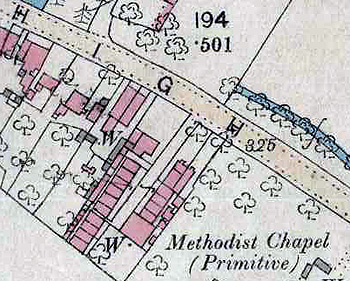Primitive Methodism in Eaton Bray

The Primitive Methodist chapel on a map of 1880
Bedfordshire and Luton Archives and Records Service has very few references to Primitive Methodism in Eaton Bray and, consequently, much of their history is guesswork. The 1st edition 25 inches to the mile Ordnance Survey map of 1880 shows a Primitive Methodist chapel in what is now Booth Place in Eaton Bray. The chapel was probably not in existence in 1851 – in that year a census of all churches, chapels and preaching-houses of every denomination was undertaken in England and Wales and there is no return for a Primitive chapel in Eaton Bray.
The chapel was part of the Dunstable Primitive Methodist Circuit and Bedfordshire and Luton Archives and Records Service has a baptism register from that circuit dating between 1866 and 1965 [MB372]. The following entries are for Eaton Bray residents:
- Thomas, son of George Thorne, butcher and Susannah his wife: 28th April 1868;
- Jabaz, son of George and Susannah Thorne: 28th April 1868;
- Ellen, daughter of George and Susannah Thorne: 28th April 1868;
- William, son of Ellen Wesley, plaiter: 15th September 1868;
- Mary, daughter of Emma Clark, plaiter: 15th September 1868;
- Martha, daughter of Elizabeth Howlett, plaiter: 15th September 1868;
- Louisa, daughter of George Gadsden, labourer and Fanny, his wife: 18th October (born 7th June) 1871;
- Ezra Charles, son of Jane and Thomas Moore: 21st January 1872 (born 23rd March 1870);
- Amos Frederic, son of Samuel Impey, labourer and Elizabeth, his wife: 24th January 1872 (born 6th October 1871);
- Elizabeth, daughter of Jesse Procter, labourer and Sarah, his wife: 24th January 1872 (born 3rd November 1854);
- Ruth, daughter of William Clarke, labourer and Sabina, his wife: 24th January 1872 (born 10th December 1871);
- Harry Segatha, son of Elizabeth Duncome: 24th January 1872 (born 22nd May 1868);
- Ann, daughter of Ruth Cobb: 9th April 1873;
- Elizabeth Emily, daughter of Alfred Turley, labourer and Eliza, his wife: 11th December 1872;
- Louisa, daughter of James Ludgsden, labourer and Avis, his wife: 9th April 1873;
- Leize [?], child of Leah Standbridge: 9th April 1873;
- Ada Jane, daughter of John Standbridge, labourer and Ann, his wife: 9th April 1873;
- Ada, daughter of George and Susannah Thorne: 9th April 1873;
- Mary Ann, daughter of George and Fanny Gadsden: 9th April 1873;
- George, son of Charles Jeffs, labourer and Mary Ann, his wife: 9th April 1873;
- Jesse, son of Henry Gadson, labourer and Susan, his wife: 15th November 1874;
- James, son of Alfred Snoxhell, labourer and Elizabeth, his wife: 8th October 1879 (born 30th January 1878).
No date is recorded for the registration of the first Primitive meeting in Eaton Bray. There are three registrations which cannot be ascribed to a particular denomination – in 1817, 1825 and 1834 and so it is possible that one or more of these may be primitive registrations.
The 2nd edition 25 inches to the mile Ordnance Survey map of 1901 shows the premises formerly occupied by the Primitive Methodists as being occupied by the Salvation Army. Wesleyan Methodism had been strong in Eaton Bray for over a hundred years and, presumably, the Primitive branch of the denomination could not compete with it. However, in 1916 ten cottages known as 1 to 10 Chapel Yard were conveyed by Thomas Thorne of Luton, auctioneer to Fred Bates of Eaton Bray. They are described as abutting on part of the premises of the Primitive Methodists! It is possible that the Primitive Methodists still owned the property and leased it to the Salvation Army or, more likely, the description is simply out of date as it follows a mortgage of 1890 and may simply use that description; this is a common problem with relying on the evidence of deeds.
Ultimately, in 1932, the Wesleyans and Primitives came together, with the United Methodists to form the Methodist Church of Great Britain.